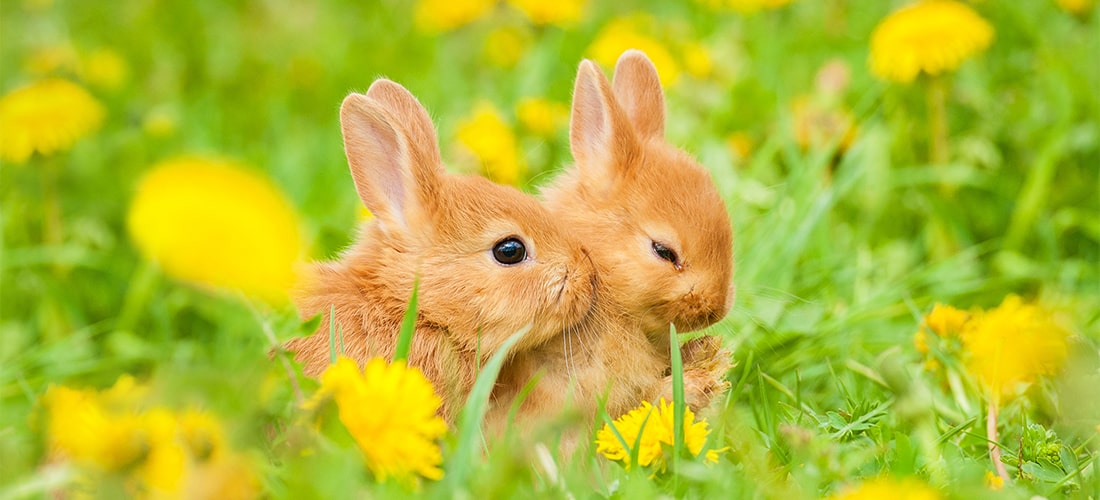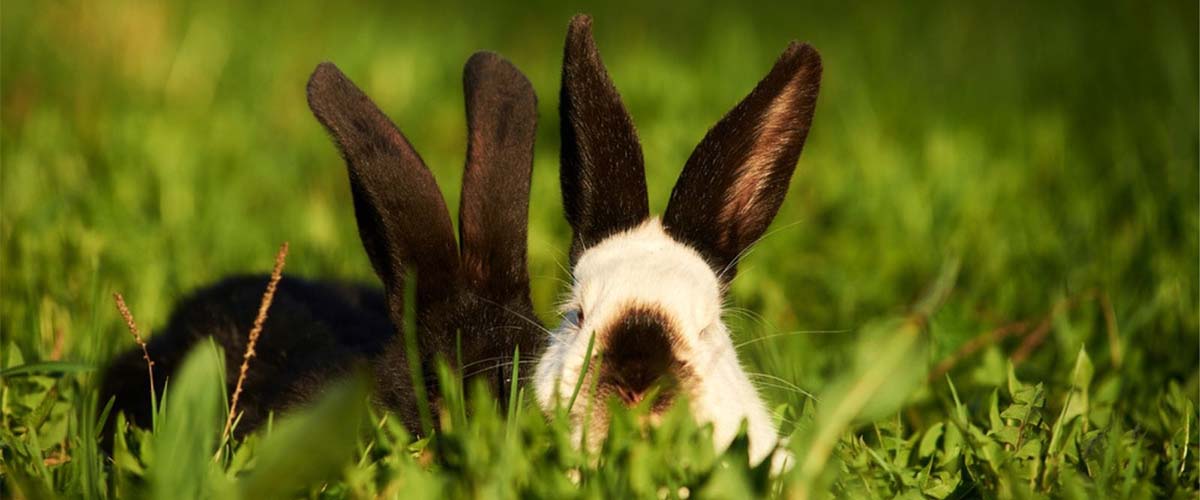Bonding bunnies: how to introduce your rabbits
Rabbits are social creatures and need the company of other rabbits to be happy. Pet rabbits need at least one bunny bestie to live with but they’ll be even happier in larger groups.
It’s easiest to adopt rabbits that are already bonded - brothers and sisters from the same litter will be really happy to live together, so long as they’ve been neutered (or you get them done when they’re old enough). If you rescue a single rabbit or your bunny’s beloved companion passes away, they can make a new friend if they’re introduced in the right way.
How to bond rabbits safely
Introducing rabbit “strangers” so that they become friends is called bonding.
You’ll need to introduce them to each other slowly and carefully. Imagine moving in with a complete stranger and being expected to be best friends right away – occasionally you might meet someone you really ‘click’ with, but mostly you won’t be crazy about them straight away! Your rabbits will also need time to get to know each other.
The whole bonding process can take as little as one day or up to several months – it all depends on your rabbits. Usually, it’s a few weeks before your bunnies will be living happily together but it is well worth the wait. Not only will your rabbit be happier living in a bonded pair or group, you’ll get so much satisfaction and enjoyment from watching them snuggling together.
Preparing to introduce your rabbits
- Find the right friend: A pair of neutered male and female rabbits are the ideal pairing to have, although it’s possible to introduce other combinations, too, as long as they’re all neutered. Look for rabbits around the same age and size if possible. You might like to look for a rescue rabbit. Check out our guide on where to get rabbits.
- Make sure your bunnies are in good health: Get them both a check-up from the vet. Illnesses or pain can make introductions harder since they will already be feeling uncomfortable – most people don’t feel very sociable if they have a horrible cold or tooth ache!
- Neuter your rabbits: Unneutered rabbits are more likely to fight. Males and females can also mate and produce a lot of baby rabbits – even brothers and sisters will mate once they’re adults. Getting your rabbits neutered before you introduce them will make the bonding process much smoother. It will also protect your rabbits from health issues like womb cancer.
- Room to relax: Give your bunny set-up a once over before you start to make any introductions. Rabbits need a lot of space to exercise and hop around. They’re also really playful animals and love to have toys to play with, tunnels to explore and dirt to dig in. If your rabbits are suddenly having to share space and toys, they might get very protective of what they have. This can make bonding more difficult and could lead to fights for a bit of personal space!
How to introduce your rabbits to each other
Use our “Three ‘S’s” to introduce your rabbits to the idea of a pal before they have to get up close and personal:
- Scent: Rabbits use their sense of smell to communicate with each other. Before your rabbits actually meet, swap toys and bedding between their hutches so they can get used to each other’s smell – think of it as a polite handshake to make the first meeting easier.
- Sight: Next, let your rabbits see each other. Keep them in separate hutches or runs but facing each other so they can see, smell and hear each other. If you have a house rabbit, you can keep them in separate rooms with a barrier between them – baby gates work well for this.
- Snacks: Feed them their favourite foods by the barrier so they become used to eating in each other’s company. Start them off a few arm lengths apart and gradually move them closer as they get more comfortable with their new friend.
Take each step slowly and look for signs that your rabbits are relaxed around each other before moving on to the next step – e.g. if they’re both happy lying against the barrier, they are comfortable being close together.
Letting rabbits meet face-to-face

When your rabbits are ready, the next stage is your rabbits meeting face to face.
- Set up your meeting ground: The first face-to-face meeting should take place in an area neither of your rabbits has been before, i.e. ‘neutral territory’. This will make them less likely to be protective of their own space and more likely to want to be sociable. Give them lots of hiding places like tubes, tunnels and cardboard boxes so if one of the rabbits feels stressed out they’ll have somewhere to hide. Make sure these hiding places are open at both ends so it’s harder for one rabbit to guard the entrance and stop the other from getting out. Scatter some tasty hay and your bunnies’ favourite treats around the area so your rabbits associate getting along together with a delicious feast!
- Let them loose: Put both rabbits into opposite ends of the area you’ve set up for them. They’ll have a choice to meet straight away or size up their new bunny buddy from afar. Sit with them and keep an eye on them at all times. Don’t worry if they begin to chase, circle or mount each other – this is normal behaviour for rabbits who’ve just met - but end the session if either rabbit looks stressed or starts a fight.
What if I don’t have space for neutral territory?
Ideally you would use a neutral space that neither rabbit has ever been. If you don’t have this, you could use a friend’s house, but this might not always be possible. If you’re struggling for space, then using two runs next to each other which the rabbits are swapped between may also work.
- Put each rabbit in separate runs next to each other but with a barrier between them - or two rooms separated by a baby gate for indoor buns.
- Keeping them apart but swap each rabbit over into the other run several times each day. This helps to stop the rabbit’s deciding a run is their own territory.
Watch the rabbits to see if they lie down near each other by their barrier. If they seem to be getting along, try putting them together in the same run, which both rabbits will now think of as “neutral ground”.
Signs to look out for when bonding rabbits
Your rabbits probably won’t know what to make of each other at first. It’ll take a couple of introductions before they’re happy and confident in each other’s company. When you first introduce them, they might react by:
- Ignoring each other: This is quite common especially when you first let them out into neutral territory. They’ll usually spend a few minutes exploring and getting their bearings before approaching the other rabbits. Bunny bonding can’t be rushed! Just be patient and wait to see how they interact.
- Nuzzling, sniffing and grooming each other: Congratulations! These are great signs that your bunnies are getting on well. Move onto the final step in their bonding journey – putting them together in the home they’ll share. Keep a close eye on them in the first few days. If their behaviour changes, you might need to separate them again and give them a bit more time to bond.
- Mounting each other: This is really common when you first introduce two rabbits. Mounting – or ‘humping’ – is one way that rabbits sort out who’s the boss in a pair or group. They might nip or pull each other’s fur. This is normal, so don’t separate them unless they start fighting in earnest. Supervise, but leave them together for a short time (less than half an hour) before separating them again. Introduce them again every day and slowly build up the length of time they spend together. It might take a few days or even weeks before they are relaxed around each other and move onto the cuddling up stage.
- Fighting: If you rabbits start scuffling, separate them quickly by sliding a solid piece of cardboard between them or covering them with a towel and carefully removing them from the situation. Be careful – you don’t want to get bitten or accidentally hurt either rabbit by grabbing them. Fighting probably means they weren’t quite ready for their first face-to-face meeting. Go back a step and separate them with a barrier so they can spend a bit longer getting to know one another safely. Wait a few days before trying to introduce them again.
Moving your rabbits into the same home
Once your rabbits are showing signs that they’re becoming best friends – like sniffing, grooming and nuzzling each other – they’re ready to move in together.
Put them together in the home they’ll share. That might be a bunny-proofed room, or an outdoor run and enclosure. Keep a close eye on them for any signs that they’re not getting on. It’s normal to see a bit more mounting or chasing again while they work things out. But if they start getting into fights, separate them and go back a step in the bonding process. If you want your rabbits to eventually have free run of the house or garden, it’s best to introduce them in a smaller area at first and gradually expand the area they have access to.
If your rabbits seem happy and relaxed, give yourself a big pat on the back – you now have a happy pair of bonded rabbits!
Once rabbits are bonded, they should be always kept together. For example, if one bunny has to go to the vet, take their companion along to reduce their stress levels.
A broken bond
Bonded rabbits usually get on well over long periods of time. It’s not uncommon for rabbits to occasionally scuffle, even in bonded pairs, but if they are having proper fights and pulling fur out that’s usually a sign that their bond has broken.
Usually, something has happened to break the bond two rabbits have. This might be a period of separation, a change in environment, if one bunny is unwell, a stressful event, or it might happen for seemingly no reason (usually there is one, but we can’t always figure out exactly what happened). If you’re not sure why it started, get both bunnies a vet check to make sure there’s no medical issues causing the problem.
If two previously bonded bunnies stop getting along, the best thing to do is to separate and restart the bonding process. For most bunnies, this will go much quicker than the first time because they do already know each other, but be prepared that it might still take a little time before they’re best friends again.
Creating the ideal home for your rabbits
Create a bunny paradise and give your rabbits the spacious, comfy home of their dreams.
Find out moreGiving your rabbit the company it needs
Find out why rabbits should be kept with other rabbits and what to do if you're introducing a new bunny into the mix.
Read morePreventing boredom in rabbits
Boredom can be a big problem for rabbits. Here are some top tips for keeping your bunnies active.
Learn more
